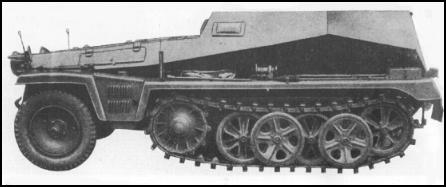
|
|
Crew |
2 |
Engine |
Maybach HL42TRKM |
Weight |
5.8 tons |
Gearbox |
7 forward , 3 reverse |
Length |
4.56m |
Speed km/hr |
60 |
Width |
1.95m |
Range |
320 km |
Height |
1.66m |
Radio |
FuG Spr Ger f |
| Armour (mm/angle) | Front | Side | Rear | Top/Bottom |
| Superstructure | 10 / 30º | 8 / 35º | 8 / 17º | open |
| Hull | 14.5 / 12º | 8 / 30º | 8 / 45º | 6 / 90º |
|
In 1939 after successful trials of the light semi-track troop carrier the Army indicated their requirement of a similar vehicle capable of transporting a Halbgruppe (half platoon) thereby increasing the flexibility of reconnaissance units.Büssing-NAG were entrusted with the development of the armored body and Demag with the chassis which was to be based on their existing Zgkw It (Sd Kfz 10).Prototypes were already available powered by the Maybach NL38 motor.Because of delays the production series was not started until June 1941 when the first thirty-nine vehicles were completed.Up to October 1943 only minor modifications were incorporated in the production vehicles but twelve official sub-variants existed each having a special-purpose configuration.After October 1943 this version of the le SPW was known as 'Alte' (old). The Sd Kfz 250 consisted of a modified Demag D7 tractor chassis mounting an armored body.In order to maintain the performance of this limited payload vehicle was fitted with the armored superstructure , Demag shortened the chassis and removed the forward wheel and torsion bar.The lubricated tracks provided some of the steering , though for normal road use the front wheels were sufficient. The bulk of the sub-variants were issued to Panzer Aufklärungs detachments of Panzer and Panzergrenadier divisions.Tle light reconnaissance company which used these vehicles was normally issued with twenty-eight were attached to a Panzer division or eighteen when with a Panzergrenadier division.The ammunition carriers and observation vehicles were attached to Strumgeschütz units. |